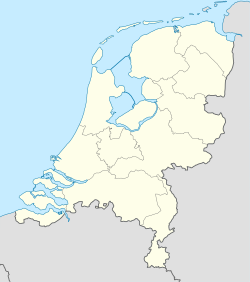Nieuw-Schoonebeek
Village in Drenthe, Netherlands From Wikipedia, the free encyclopedia
Nieuw-Schoonebeek is a village in the Netherlands and is part of the Emmen municipality in Drenthe.
Nieuw-Schoonebeek | |
|---|---|
 Churchtower in Nieuw-Schoonebeek | |
Location in province of Drenthe in the Netherlands | |
| Coordinates: 52°38′N 6°59′E | |
| Country | Netherlands |
| Province | Drenthe |
| Municipality | Emmen |
| Established | 1814 |
| Area | |
• Total | 17.69 km2 (6.83 sq mi) |
| Elevation | 14 m (46 ft) |
| Population (2021)[1] | |
• Total | 1,285 |
| • Density | 73/km2 (190/sq mi) |
| Postal code | 7761 |
| Dialing code | 0591 |
History
Nieuw-Schoonebeek started as a peat exploitation settlement along the road from Schoonebeek to Meppen. Around 1805, settlers from neighbouring Twist in Germany moved into the area.[3] The village was officially founded in 1814.[4] In 1849, a Catholic church was built in Nieuw-Schoonebeek, and was replaced in 1966–67 with a new church. The tower of the old church has remained standing.[3]
In 1943, oil was discovered in neighbouring Schoonebeek. The population successfully sabotaged the wells which prevented the Germans from knowing much oil was underneath the ground. After the war, pumpjacks became a feature of the landscape around the village. About 190 wells were dug in Nieuw-Schoonebeek.[4]
Nieuw-Schoonebeek is home to several boôs, little sheds where cow shepherds could spend the night with their cattle.[3]
Notable people
- Pascal Huser (born 1995), footballer[5]
Gallery
- Hekman's boô
- Automobile repair shop
- Border crossing
References
Wikiwand - on
Seamless Wikipedia browsing. On steroids.





